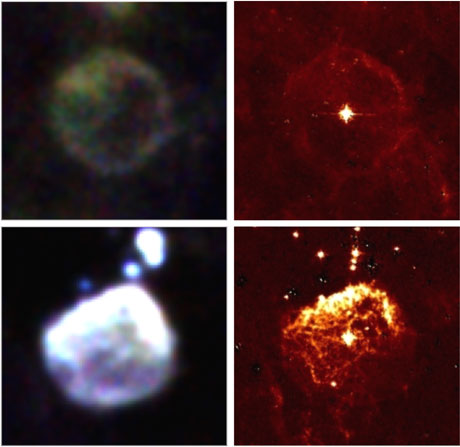Pushy neighbors force stellar twins to diverge
In a similar manner to how the environment can influence individuals, cosmic communities also have an impact on even the most massive and dazzling stars. By observing the center of the Milky Way galaxy from a high-altitude observatory, astronomers from Cornell University have made a remarkable discovery. They have found two rare stars, known as luminous blue variables, which possess identical characteristics but have distinct dusty and gaseous outer layers. These differences are a direct result of the influence exerted by a neighboring cluster.
Located 25,000 light years away from Earth, within the outskirts of the Milky Way galaxy, these luminous blue variables are scarce and short-lived. They are incredibly bright, shining a million times brighter than our own sun. The two stars in question, the Pistol star and LBV3, are both luminous blue variables and share the same size, gas-to-dust mass ratios, and total gas masses. However, their outer nebulae, which consist of dust and gas, exhibit significant variations.
To illustrate this, imagine two stars that are identical in nature but possess different outer shells. The nebula surrounding the Pistol star, despite its intense brightness, appears distorted or warped. On the other hand, LBV3’s nebula forms an almost perfect spherical shell. Ryan M. Lau, a doctoral candidate in astronomy at Cornell University, explains that these luminous blue variables are exceptionally rare, with only 12 known to exist. However, each of these stars is enveloped by a unique nebula filled with dust and gas, resulting in distinct appearances.
According to the researchers, both the Pistol star and LBV3 were formed under similar conditions. The dust in the nebula surrounding the Pistol star is bright, compacted, externally heated, and ionized due to its close proximity to neighboring stars in the Quintuplet Cluster.
In contrast, the LBV3 nebula is faint, symmetrical, and cooler. The progression of LBV3’s nebula occurs naturally in an outward manner, thanks to its relative distance from other celestial objects.

Senior author Terry Herter, a Cornell professor of astronomy and department chair, explains that the initial focus on the Pistol star was its high luminosity. However, the nebulae surrounding both the Pistol star and its sister star, LBV3, have proven to be quite intriguing. Despite being on the outskirts of the Quintuplet Cluster, the Pistol star is still influenced by the rest of the cluster, even though it is approximately six light-years away from the cluster’s center. This distance is about 1.5 times the distance from our solar system to the nearest star.In order to overcome the obscuring effect of cosmic dust on both stars, astronomers require a midrange infrared telescope.
To observe the inner galaxy from above the Earth’s atmosphere, the astronomers utilized the Stratospheric Observatory for Infrared Astronomy (SOFIA), a modified Boeing 747 SP that reaches an altitude of 43,000 feet. They used the Faint Object InfraRed Camera for the SOFIA Telescope (FORCAST), which was developed at Cornell, to study these highly luminous objects.The research, titled “Nature Versus Nurture: Luminous Blue Variable Nebulae in and Near Massive Stellar Clusters at the Galactic Center,” was co-authored by Mark Morris from the University of California, Los Angeles, and Joe Adams from the SOFIA Science Center, NASA Ames Research Center.
The research was funded by NASA and the Universities Space Research Association. Prior to this, Lau had served as an intern at Cornell University, thanks to the National Science Foundation-funded Research Experiences for Undergraduates program, during their time as an undergraduate student at Reed College.
This article is republished from PhysORG under a Creative Commons license. Read the original article.
Do not forget to share your opinion with us to provide you with the best posts !



0 Comments